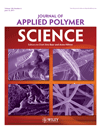Biodegradable and photocurable multiblock copolymers with shape-memory properties from poly(ε-caprolactone) diol, poly(ethylene glycol), and 5-cinnamoyloxyisophthalic acid
Abstract
Biodegradable and photocurable multiblock copolymers of various compositions were synthesized by the high-temperature solution polycondensation of poly(ε-caprolactone) (PCL) diols of molecular weight (Mn) = 3000 and poly(ethylene glycol)s (PEG) of Mn = 3000 with a dichloride of 5-cinnamoyloxyisophthalic acid (ICA) as a chain extender, followed by irradiation by a 400 W high-pressure mercury lamp (λ > 280 nm) to form a network structure. The gel contents increased with photocuring time, reaching a level of over 90% after 10 min for all copolymers without a photoinitiator. The thermal and mechanical properties of the photocured copolymers were examined by DSC and tensile tests. In cyclic thermomechanical tensile tests, the photocured ICA/PCL/PEG copolymer films showed good shape-memory properties at 37–60°C, with both shape fixity ratio and shape recovery ratio over 90% at a maximum tensile strain of 100–300%. The water absorption of these copolymers and their rate of degradation in a phosphate buffer solution (pH 7.0) at 37°C increased significantly with increasing PEG content. The novel photocured ICA/PCL/PEG multiblock copolymers are potentially useful in biomedical applications. © 2011 Wiley Periodicals, Inc. J Appl Polym Sci, 2011




